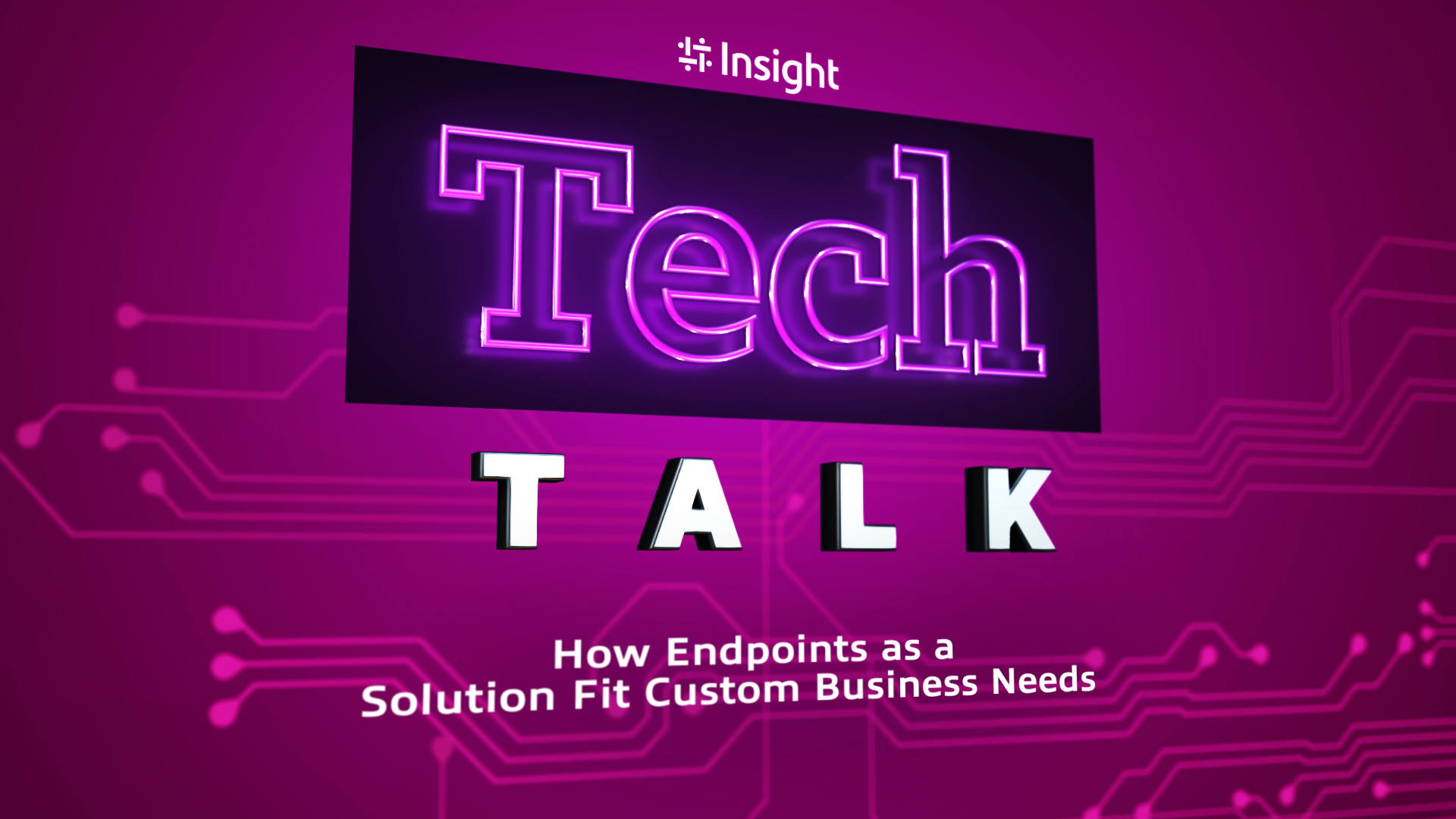TechTalk How Endpoints as a Solution Fit Custom Business Needs
By Insight Editor / 30 Oct 2022
By Insight Editor / 30 Oct 2022
As ongoing research continues to indicate that the future of return to work will include a degree of hybridity for everyone, organizations are seeking to scale their workspaces in such a way that empowers people to make their own choices on how they work. In this TechTalk, Insight Canada SVP & General Manager John Dathan is joined by Amit Bhaga, Canadian Country Leader for Dell Technologies' Client Solutions Group, to envision hybrid technology environments that stimulate a compelling end user experience.
To experience this week’s episode, listen on the player above, watch the conversation below or scroll down to read a complete transcript. You can also subscribe to Insight TechTalk on iTunes, Spotify, Stitcher and Google Play.

Transcript of audio:
JOHN
Hello and welcome to Insight's TechTalk. This is our show where we bring industry expertise and thought leadership to share with our clients the most important topics that we're seeing the technology arena. Today, I'm really pleased to say our guest is the client solutions country leader for Canada for Dell Technologies, Amit Bhaga. Welcome Amit.
AMIT
Hey John, how's it going today?
JOHN
Awesome. Really, thanks for taking the time to join us, and I'm excited about our conversation. And I thought I would do something a little bit differently today, just to sort of frame the topic with kind of a statement that I'll read. And that says that the ongoing research continues to indicate that the future of return to work will include a degree of hybridity for everyone, and that organizations are seeking to scale their workspaces in such a way that empowers people to make their own choices in how they work. And so why don't I ask you at the high level, you know, your thoughts around that topic and how Dell is responding to that.
AMIT
Well, absolutely. You know, it's hard to say it's been three years since the world and businesses have been flipped upside down, you know? Most customers have finally accepted their new normal, whether it's all their employees going fully remote or part-time, whatever you want to call it, a hybrid workforce or a gen work-from-home, it is here to stay, right? So here at Dell, we've been living with connected workforce since 2009. It was a strategic component of our company's culture and operations, and it really allowed our employees to choose the work style that best fulfills them based on the needs of their job, as well as their life in a highly mobile, collaborative, flexible work style and setting, and you know, hybridity, yeah, it is here to stay. What we are now seeing, the challenge that is popping up with a lot of customers is really managing that digital experience across your workforce, right? There's differences in age, roles, workflows, and ensuring that that digital experience is consistent, reliable, and an intelligent one for their employees, that's the real tough, the tough part of it. You know, believe it or not, a lot of our employees that are out there are choosing customers or where they're working based on the technology and digital experience that is provided to them, right? So, and this is not a new phenomenon, right? This was before the new normal, right? It just now have been, has been exponentially highlighted in a way where, you know, technology's that enabler for employees, but our goal as leaders is, how do we unlock that productivity in this new do from anywhere workplace? So you know, today and throughout the pandemic, you know, Dell Technologies has helped a lot of our customers and partners through that journey.
JOHN
Yeah. I think you're so right, and the expectations of people, quite honestly, they start with perfection, right? I mean I've personally actually been working hybrid, I counted it based on the age of my kids, I've been doing it for 34 years, and so I go back to the literally dial-up days, right, where you know, a very different experience, but today, I go from a home office where I'm encrypt in one way to where I'm on the road to where I'm in a hotel to where I'm in other areas, and you're right that that experience, when it's not up to the standard that we're now used to, it really falls short, and the frustration level is extremely high.
AMIT
Absolutely, and when you say hybrid, right, you know, there's a way that we work when we're at home or remote or, you know, at a Starbucks or a Tim Hortons, but you know, having that on-site presence is how do you blend that physical and virtual, you know, 24 hours Zoom, when we were in the pandemic, but now as we start to open up, it's like, oh crap, I have a meeting in five minutes but I'm not going to be able to get there, so I got to do it, you know, on the spot, so you know, that do from anywhere is more impactful now to our employees and how they do work. It is something that a lot of customers have to start think about.
JOHN
Yeah, I agree. So when you think about it, I mean is the most important thing the connectivity, or is there other areas that require high performance?
AMIT
Well connectivity's a big portion, right? A lot of customers have moved to now SaaS-based applications, you know, to do your job and get to that data and the applications, you do need, you know, you need connectivity, but we are seeing sort of an increase in performance requirements for these hybrid workers. You know, back in 2020, you know, two things that were flying off the shelves were toilet paper and PCs, right? I think we can agree on that. But the issue with customers, you know, what they're facing now is, they brought in systems to support hybrid workforce, but that was for an employee prior to the pandemic, right? Our customers didn't really anticipate the adoption of 24-hour Zoom video calls, or the introduction of a powerful yet very, very power-hungry application called Microsoft Teams. And then on top of that, you're adding advanced workflows and tasks to your traditional knowledge worker, and what we've seen is that knowledge worker is now moving into this power user persona, demanding more compute requirements at the edge to maintain their productivity. And this has actually been a very, very massive catalyst into why organizations have been gravitating towards our industry-leading Precision workstation portfolio, because, you know, it has the compute there, you know, they're LE only design mobile workstations, a ton of power in a small package, you know, 14, 15, 16-inch, 17-inch form factors, but really what we're doing is we have that technology enabler in our mobile workstations, or fixed, to allow that hybrid work, you know, force to thrive.
JOHN
Yeah. Well you're right, and we have so many applications running at the same time, and as you say, you know, Teams, this is a, I mean it's the type of application, it's using video, it's using audio, so the speed of your memory, the speed of your drives, all of those kind of things, they do matter.
AMIT
Yeah, absolutely. I mean, I'm using a workstation right now and the reason why is like I have Teams in the background, we're on this StreamYard, you know, application I've never used before, and you know, my system just needs to handle that, so it's almost that you need that Swiss Army knife of a system to manage all these different types of workflows that our customers and employees are dealing with.
JOHN
Yeah. So maybe I'll just be devil's advocate, so everything's in the cloud.
AMIT
Go for it.
JOHN
Cloud, cloud, cloud, it's all we hear about these days, right? And so whether, you know, we mention Teams or you know, an M365 user, et cetera, et cetera, is the device moving almost backwards in importance, you know, when you think of terminal days for example, is it just, this is just an access mode, or does it, do you feel it's even more important?
AMIT
Well, I'm part of this client solutions group at Dell, and you know, we own everything from the desk to the collaboration boardroom, you know, even into cloud client compute, and so the question is, you know, does the device matter? The device always matters, but there are still workloads that you still can't optimize, you know, for cloud or virtualization. You know, you have the usual constraints of compute connectivity and storage, and we are seeing a lot of customers asking for, hey, I need a system that can manage, you know, data visualization, or manipulating extremely large datasets, or even into data science modeling, right? There's a lot of data science, AI, machine learning, some of that stuff you just can't model into the cloud, you have to actually do it on a, you know, on a workstation type of platform. So you know, I do see a need for your personal compute, but there will be instances where cloud client compute, you know, will excel in, depending on the workflow that you're providing for your employee.
JOHN
Yeah, good point. What are your thoughts, and we didn't really talk about this before, but sort of device-level security?
AMIT
Well, device-level security's very, very important. I mean, now more than ever, right, because when you're providing a whole ton of machines that, you know, traditionally were locked down in an environment, you know, you have your actual lock and key at your office, you know, your RFID badges to get in, y'know, hackers can get anywhere, right? You now have spread of mobile devices across your network, regionally, geographically, you know, so what we need to make sure is that we have certain protocols and layers of protection to ensure that, you know, you are at a point where you have zero trust security, so is it, you know, are you using, you know, biometric? Are you using, you know, two-layer or 2FA? You know, within the Dell devices, we do have, you know, security below and above the OS, so you know, stuff that you don't really have to think about, you know, having an ability to ensure that there's a, something that's kind of out of the hands of a customer, right, in terms of security, so you know, look-away cam, all these types of things that you would want to have on a device to ensure that security at the actual hardware level is there, but then you know, it kind of ties into the security level of what you're doing across your network.
JOHN
Yeah. Well, and I would say as a user, things like facial recognition to log into my device, right? Hey, every password that I don't have to remember is better, and every password that I don't have to change, 'cause thankfully my face doesn't change that often, just makes like easier, and to support your point around the, you know, some of the security piece, y'know, we went from six offices across Canada to effectively over 500, because everybody went from being, as you say, physically in the office to, for a long period of time, 100% working from home.
AMIT
Absolutely. Yeah, and you know, that entails another, you know, challenge, right? You can secure the home, but when that device kind of travels out of the home, what do you do when you're at that, you know, that other place where you don't really know, is it a secure network? Are there people or prying eyes, you know, behind me, so you know, we start talking about that security innovation, you know, across the hardware device and, you know, into the cloud.
JOHN
Yeah. Well listen, we really appreciate you joining us today. Given your role, you work for a terrific organization, any sort of final thoughts for our clients today?
AMIT
Well absolutely. You know, the one thing is is that we are here to help, right? It's a little less frantic out here these days, and you know, take the time to reach out to Insight, a great Dell partner. You know, we have an army of resources across Canada supporting Insight and our customers, and let's chat about where you're at, but let's really align on what type of productivity you want for your evolving workforce, because this is an evolution, right, you know? The new normal is here to stay, but that new normal may change, right? So we have to make sure that we have these conversations now instead of, you know, waiting when that, you know, that issue arises again, right? Hopefully it doesn't, knock on wood.
JOHN
Not in the same way, that's for sure. Well thanks for joining us today Amit, we really do appreciate it, and thanks to joining us today. We look forward to talking to you next time on Insight's TechTalk.
AMIT
Absolutely, thanks for having me.

Country Leader, Canada Client Solutions Group, Dell Technologies
Amit Bhaga is the Canada Country Leader for Dell Technologies Client Solutions Group. Amit has responsibilities for driving technology experience strategies focused on your workforce. He is also a board member on the Dell Technologies Client Sales Advisory Board. Throughout his 15-year tenure with Dell Technologies, Amit has evangelized the importance of delivering an unmatched customer experience through digital transformation. Amit holds a Honours Bachelors of Science from the University of Toronto, specializing in Human Health and Disease. He currently lives in Toronto Ontario with his wife and son.

Senior Vice-President & General Manager, Insight Canada
In 2018, John joined Insight with more than 30 years of sales and business management experience in IT. John fosters deep partner relationships and meaningful connections with clients. He guides Insight Canada’s overall strategy to meet their needs through unique processes, tools and services provided via Insight Intelligent Technology Solutions™ in supply chain optimization, connected workforce, cloud and data centre transformation, and digital innovation.